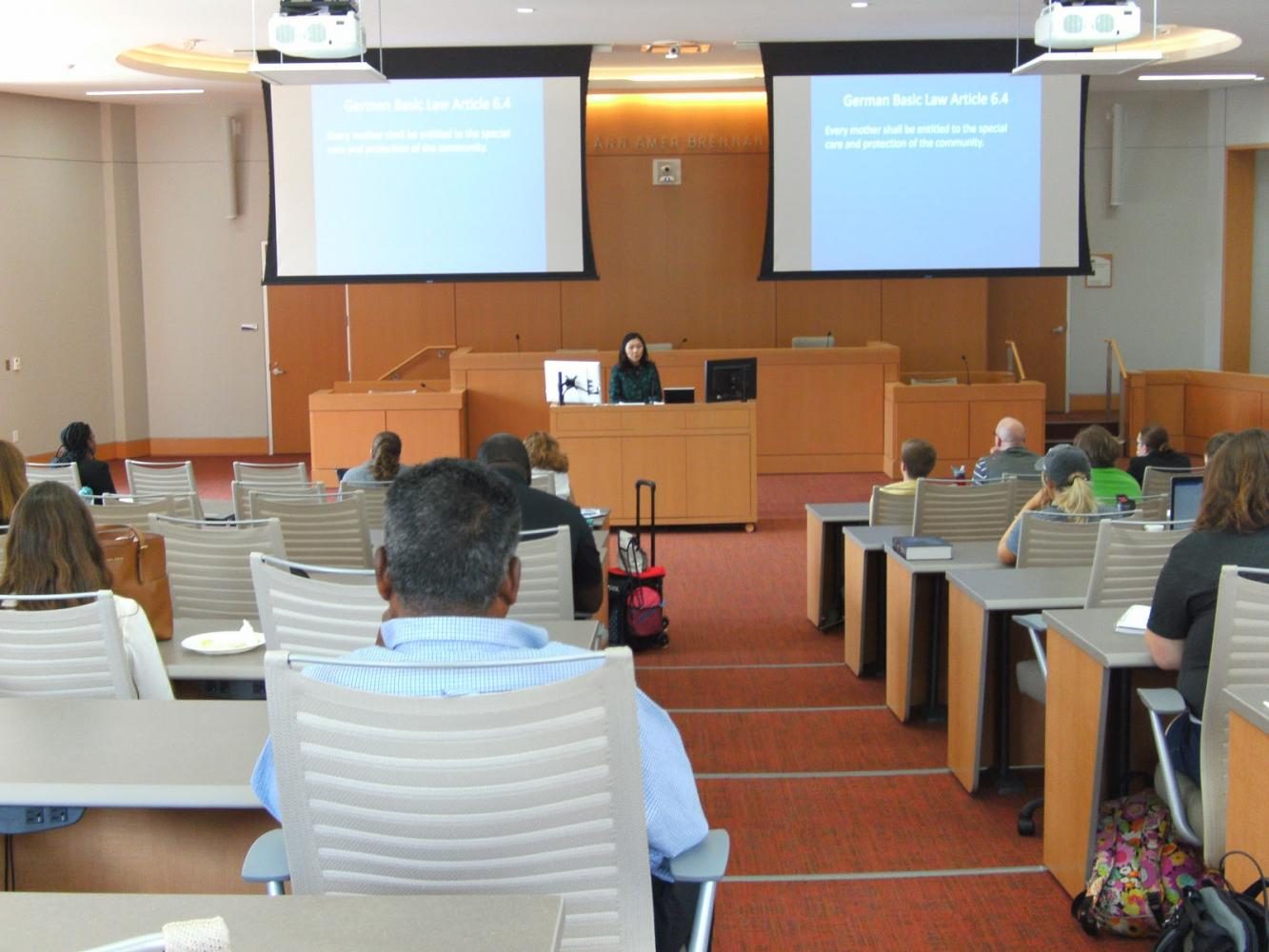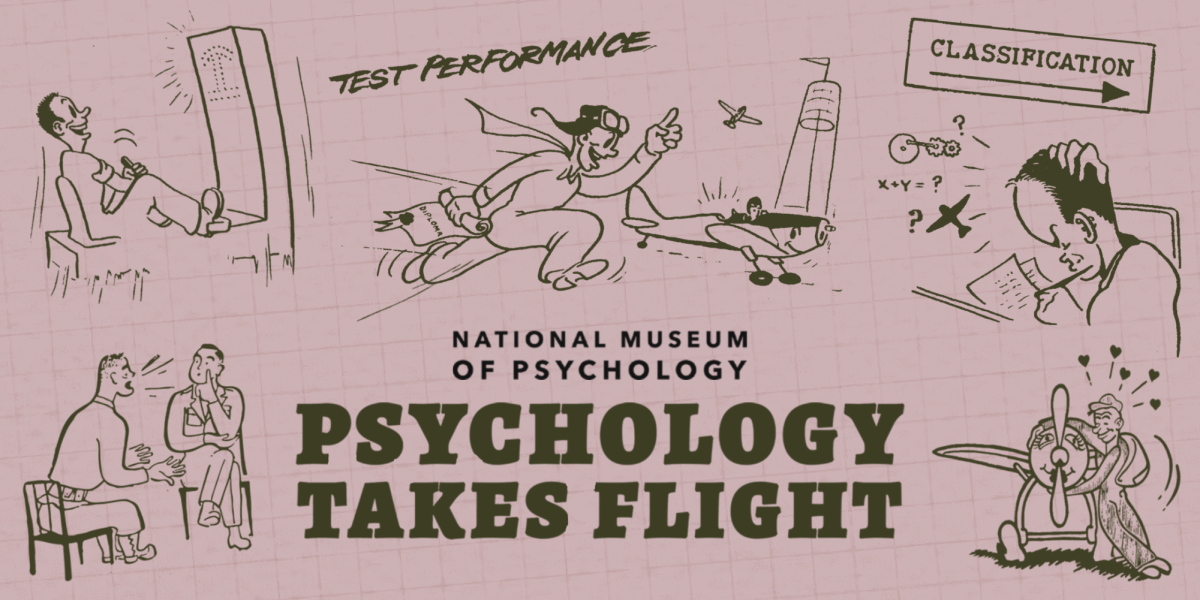Cardozo’s Julie Suk Speaks About Image of Equal Rights Amendment to Celebrate Constitution Day
Suk lectures to a room full of students and staff in the Brennan Courtroom in the School of Law.
September 19, 2017
Julie Suk, a professor of law at the Cardozo School of Law, spoke in a lecture at The University of Akron’s School of Law Monday afternoon about how constitutional equality should go beyond gender equality and reach disadvantages faced by women.
The lecture, which was titled, “The Constitution of Mothers: Gender Equality and Social Reproduction,” took place in the new Brennan Courtroom at the University’s law school. In the lecture, Professor Suk highlighted the role of motherhood. Many countries, such as Germany, have guaranteed protections and rights for mothers in their constitution to promote greater gender equality, she said. This is a way countries go beyond simply promoting gender equality.
Professor Suk said solely prohibiting sex discrimination is inadequate to address the damaging effects of raising children on women. She gave the gender wage gap as an example of this. She said that the gender gap is really the motherhood gap. The gap narrows significantly if you compare women who are not mothers to men, Suk said. However, there is a large gap if you compare mothers who work to men, whether or not the men are fathers.
Because of this discrimination, an equal rights amendment is needed for the United States, but it must be one that exceeds gender equality and protects disadvantages women face, such as disadvantages they face as mothers. Unfortunately, an equal rights amendment like the one that was approved by the Senate in 1972 would not meet these expectations.
Recently, Nevada ratified the Equal Rights Amendment, 35 years after the deadline to ratify the ERA had passed. If Nevada’s ratification could be made valid through congressional action, only two more states would have to ratify the ERA for it to be put on the United States Constitution. However, Suk said that the ERA, at this point, may not actually change the law and would be purely symbolic. This is because since the time of the ERA, other laws have passed that guarantee equality for women. An example of this is Title IX. These laws give women the equal rights the ERA would have given to them.
At the end of the day, an equal rights amendment is still necessary in the United States, but it must have a different vision than the one that was passed in the Senate in 1972.
The event was held by The Center for Constitutional Law to celebrate Constitution Day. The Center for Constitutional Law is one of four resource centers established by Congress in 1986 to research and inform students and the public about constitutional issues.
The director of The Center of Constitutional Law, Tracy Thomas, has a blog that features similar issues as the lecture. The blog is titled “Gender and the Law Prof Blog.” Tracy Thomas also attended the event.
Julie Suk has degrees from Harvard, Yale, and Oxford. Some of her publications include “Are Gender Stereotypes Bad for Women? Rethinking Antidiscrimination Law and Work-Family Conflict,” “Discrimination at Will: Job Security Protections and Equal Employment Opportunity in Conflict,” “Procedural Path Dependence: Discrimination and the Civil-Criminal Divide” and “Gender Parity and State Legitimacy: From Public Office to Corporate Boards.”















Laura Carter Callow • Sep 21, 2017 at 12:40 PM
I have been working for ratification of the Equal Rights Amendment since the early 1970s. I read your remarks that the ERA is only ’symbolic’ with utter dismay. It has taken 94-years to get this far (36 ratified states). The reason is because the ERA is mainly about equal pay and strong economic interests oppose it. (Someone is making money by paying women less.) That’s far from symbolic. You seem willing to trash the millions of dollars and the millions of women hours already invested in seeking ratification for this ERA, for something you believe is new and improved. If women had gotten behind the present ERA in the 1940s, Goesert v Cleary would have been decided differently. A mere ten years ago, Ledbetter v. Goodyear Tire & Rubber Co., 550 U.S. 618 (2007) would also have been decided in favor of the plaintiff. The book and movie, “Equal Means Equal,” cite numerous other cases that were decided unjustly because we do not have the ERA. Unless women get together and demand ratification of the ERA now, justice and constitutional equality for women will remain at the whim of the courts for another century or more. Why are you advocating that we wait that long?
Kamala Lopez • Sep 21, 2017 at 12:08 PM
I must say, I second what Ms. Cook says above and beyond that, I am disturbed and surprised that a professor would perpetuate the misinformation and gas lighting of multiple generations of young women. Terrible shame.
Symbolic? Equal Rights?? ERA?! Really, Ms. Suk?! May I ask whether you receive any funding from insurance companies? Or perhaps some other vested interested in our continued suppression and degradation? Waiting to include all those items you suggest is nothing more than a poorly disguised attempt to kick the can down the road one more time while three women die in this country every single day and Walmart continues to economically rape its female employees unabated. Is Walmart a funder of your university?
Harvard? Yale? Oxford? Honestly, this doesn’t speak well for our most lauded institutions of higher education. Although it’s not surprising given the economic collusion and sleight of hand that ALL our major systems and establishment institutions continue to play with women’s lives, health and ability to survive. Please educate yourself by watching my film Equal Means Equal and stop sabotaging the potential for 162 MILLIION people to finally have the inalienable rights they were born with. I strongly suggest you retract and correct this misinformation after you watch the film and start to work on getting these last two states ratified. I assure you, Ms. Suk, there will be nothing symbolic about that victory. It will be actionable, enforceable and the first real step we, as a country, have taken to rectify this appalling exclusion of women in the U.S. Constitution.
Young women cannot afford to be send on another multi-generational quest for the holy grail. We’re sick and tired of waiting for the Great Oz to give this country a heart and some brains. We demand equal rights under the law NOW. This is not symbolic – this is survival. Join the fight or face a fight because the time for politesse is way over.
Kathie Kelly • Sep 21, 2017 at 12:54 AM
Well said, Carolyn. When you have a class of the population (probably more than half) who are not recognized in the Constitution and who are discriminated against because of their physical makeup, the Constitution needs to address the issue.
Just turn the tables and imagine a country where men were denied the same wages as women for the same work; where men’s access to healthcare was slowly being denied; where men were penalized for normal bodily functions, and you will see the absolute absurdity of the present situation.
Carolyn Cook • Sep 20, 2017 at 5:05 PM
As an ERA lobbyist, single woman and former HR Work/Life professional, I find your commentary on the ERA rather ill-informed to claim that it’s symbolic and ignores the plight of mothers. Since the ERA didn’t pass by 1982, businesses have shouldered an inordinate amount of responsibility for accommodating the role of caregivers in the workplace. There has been little to no support, incentives or enforcement from the federal government to enact new policies that meet the needs of our modern workforce as other developed countries have adopted. The US is an embarrassment to be among the few countries that never ratified CEDAW or an ERA let alone elect a woman president. You fail to consider that with an ERA, the government would be accountable to address the role of women and men in the workplace as parents and to come up with policies to accommodate them. Parenting has become far more integrated into the lives of men and women since the 1970s. Men face gender discrimination when parental leave is denied or discouraged. Families are harmed when mothers or fathers are not compensated equally. Men and women are struggling without affordable child, elder and health care which will continue to be ignored without a change in women’s status. Beyond your own concerns, It’s not a secret that the legal system ignores women’s lived experiences as victims and survivors when it comes to how the law protects the rights of predominantly male perpetrators. The law that protects women from violence has remained inadequate for centuries. There are few resources addressing prevention and far too many resources that must wait to intervene until after the violence has occurred. In the case of state discrimination, the burden of proof lies with women plaintiffs to prove injury. Whereas, the similar 14th Amendment shifted the burden to the government when it comes to racial discrimination. I would encourage you to look beyond your silo to the reality and accountability of having a statement of gender equality in writing after 228 years as a starting point for society to evolve and attitudes to change and for government to respect the autonomy of women for the first time and recognize our value to the economy outside of the home. Thereby seeking new and innovative ways to move our country together as one human race and bridge the gaps that exist versus continue to widen them with impunity.